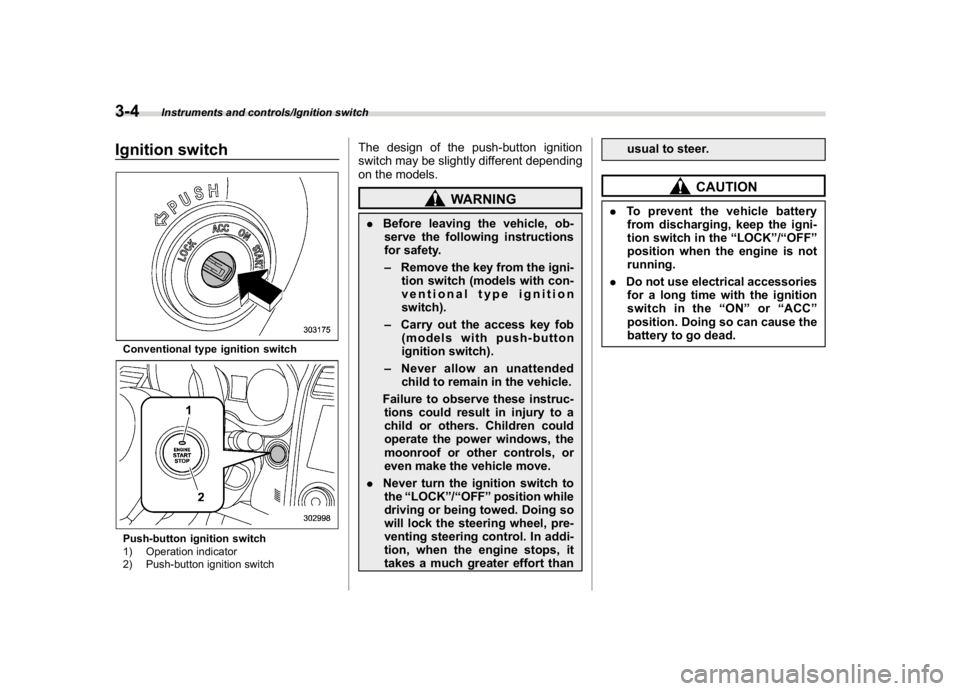Page 141 of 578

(146,1)
北米Model "A1700BE-B" EDITED: 2017/ 10/ 11
Ignition switchConventional type ignition switchPush-button ignition switch
1) Operation indicator
2) Push-button ignition switch
The design of the push-button ignition
switch may be slightly different depending
on the models.
WARNING
.Before leaving the vehicle, ob-
serve the following instructions
for safety.
–Remove the key from the igni-
tion switch (models with con-
ventional type ignition
switch).
–Carry out the access key fob
(models with push-button
ignition switch).
–Never allow an unattended
child to remain in the vehicle.
Failure to observe these instruc-
tions could result in injury to a
child or others. Children could
operate the power windows, the
moonroof or other controls, or
even make the vehicle move.
.Never turn the ignition switch to
the“LOCK”/“OFF”position while
driving or being towed. Doing so
will lock the steering wheel, pre-
venting steering control. In addi-
tion, when the engine stops, it
takes a much greater effort thanusual to steer.
CAUTION
.To prevent the vehicle battery
from discharging, keep the igni-
tion switch in the“LOCK”/“OFF”
position when the engine is not
running.
.Do not use electrical accessories
for a long time with the ignition
switch in the“ON”or“ACC”
position. Doing so can cause the
battery to go dead.
Instruments and controls/Ignition switch
3-4
Page 145 of 578

(150,1)
北米Model "A1700BE-B" EDITED: 2017/ 10/ 11
NOTE.When operating the push-button
ignition switch, firmly press it.
.If you press the push-button ignition
switch quickly, the power may not turn
on or off.
.If the indicator light on the push-
button ignition switch flashes in green
when pressing the push-button ignition
switch, steering is locked. When this
occurs, press the push-button ignition
switch while turning the steering wheel
left and right.
!Battery drainage prevention func-
tion
When the push-button ignition switch is left
in the“ACC”or“ON”position for approxi-
mately 1 hour, the push-button ignition
switch will be automatically switched to
“OFF”to prevent the battery from going
dead. (In CVT models, this function is
activated when the select lever is in the“P”
position.)
!When access key fob does not
operate properly
Refer to“Access key fob–if access key
fob does not operate properly”F9-26.
Hazard warning flasherUse the hazard warning flasher to warn
other drivers when you have to park your
vehicle under emergency conditions. The
hazard warning flasher works regardless
of the position of the ignition switch.
To turn on the hazard warning flasher,
push the hazard warning button on the
instrument panel. All the turn signal lights
and the turn signal indicator lights will
flash. To turn off the flasher, push the
button again.NOTEWhen the hazard warning flasher is on,
the turn signals do not work.
Meters and gaugesNOTELiquid-crystal displays are used in
some of the meters and gauges on the
combination meter. You will find their
indications hard to see if you wear
polarized glasses.&Combination meter illumina-
tionWhen you turn the ignition switch to the
“ON”position, the various parts of the
combination meter are illuminated in the
following sequence.
1. Warning lights, indicator lights, meter
needles, gauge needles illuminate.
2. Meter and gauge indications each
show MAX position.
3. Meter and gauge indications each
show MIN position.
4. Regular illumination (for driving) be-
gins.
Instruments and controls/Hazard warning flasher
3-8
Page 372 of 578

(385,1)
北米Model "A1700BE-B" EDITED: 2017/ 10/ 11
Continuously variable trans-
missionThe continuously variable transmission is
electronically controlled and provides an
infinite number of forward speeds and 1
reverse speed. It also has a manual mode.
WARNING
Do not shift from the“P”or“N”
position into the“D”or“R”position
while depressing the accelerator
pedal. This may cause the vehicle
to jump forward or backward.
CAUTION
.Observe the following precau-
tions. Otherwise, the transmis-
sion could be damaged.
–Shift into the“P”or“R”posi-
tion only after the vehicle has
completely stopped.
–Do not shift from the“D”
position into the“R”position
or vice versa until the vehicle
has completely stopped.
.Do not race the engine for more
than 5 seconds in any position
except the“N”or“P”positionwhen the brake is applied or
when chocks are used in the
wheels. This may cause the
transmission fluid to overheat.
.Never move the vehicle as fol-
lows. Doing so may result in an
unexpected accident or malfunc-
tion.
–Moving rearward by inertia
with the select lever set in a
forward driving position.
–Moving forward by inertia with
the select lever set in the“R”
position.
.When parking the vehicle, first
securely apply the parking brake
and then place the select lever in
the“P”position. Do not park for a
long time with the select lever in
any other position as doing so
could result in a dead battery.
NOTE.When the engine coolant tempera-
ture is still low, the transmission will
upshift to higher engine speeds than
when the coolant temperature is suffi-
ciently high in order to shorten the
warm-up time and improve driveability.
The gearshift timing will automaticallyshift to the normal timing after the
engine has warmed up.
.Immediately after transmission fluid
is replaced, you may feel that the
transmission operation is somewhat
unusual. This results from invalidation
of data which the on-board computer
has collected and stored in memory to
allow the transmission to shift at the
most appropriate times for the current
condition of your vehicle. Optimized
shifting will be restored as the vehicle
continues to be driven for a while.
.When driving under continuous hea-
vy load conditions such as when climb-
ing a long, steep hill, the engine speed
or the vehicle speed may automatically
be reduced. This is not a malfunction.
This phenomenon results from the
engine control function maintaining
the cooling performance of the vehicle.
The engine and vehicle speed will
return to a normal speed when the
engine is able to maintain the optimum
cooling performance after the heavy
load decreases. Take extremely care
when driving under a heavy load.
.The continuously variable transmis-
sion is a chain type system that pro-
vides superior transmission efficiency
for maximum fuel economy. At times,
depending on varying driving condi-
tions, a chain operating noise may be
–CONTINUED–
Starting and operating/Continuously variable transmission
7-23
7